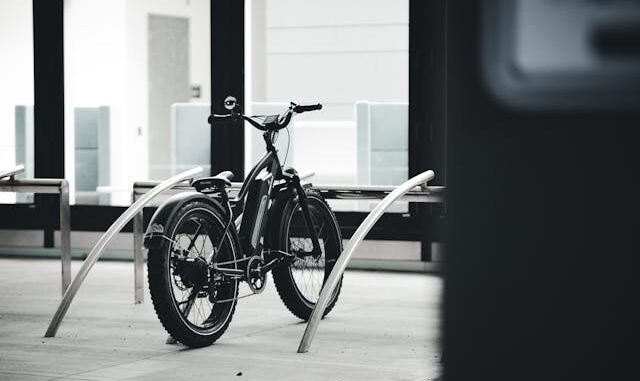
Please note: As an Amazon Associate we earn from qualifying purchases. Details here.
If you’re like me who is looking for alternative transportation that doesn’t require firing up the car engine, then electric bikes may be your go-to solution. Now, you may wonder:
Can you put an electric bike on a bike rack?
The answer is yes, but you’ll need one specifically designed to handle your ride’s unique characteristics.
First Off, What Is an Electric Bike?
An electric bike (e-bike for short) looks like your typical bicycle but comes with a battery-powered motor to give your pedaling a boost.

Unlike scooters, these bikes don’t completely self-propel, they just make your pedaling easier, especially on hills or longer journeys.
You can either purchase a purpose-built electric model or retrofit your existing pushbike with a motor kit.
Either way, you’re still cycling, just with some welcome assistance when your legs need a break.
Can You Store an Electric Bike on a Regular Bike Rack?
Yes, you can mount an e-bike on a standard rack, but you’ll likely need to make some adjustments first.
You might have to tweak the rack frame if your model allows for customization. Often, you’ll need to remove components like your horn, battery, or basket to ensure a proper fit.
The extra bulk and weight of electric bikes means standard racks sometimes need a bit of help to accommodate them properly.
How Do You Fit an E-Bike on a Bike Rack?
1. Check Weight Capacity
The most crucial factor is confirming whether your rack can handle your e-bike’s weight. If you’re uncertain, look up the specifications for both your rack and bike online or dig out the owner’s manual.
I always recommend staying 5-10 pounds below the maximum weight capacity.
This small buffer could make all the difference between arriving with your bike intact versus finding pieces of it scattered along your route.
2. Check Size and Shape
Here’s what the Biking Universe warns about:
“The last thing you want is to attempt to bring your e-bike somewhere, only to find its parts scattered along the highway. You never want to exceed the weight capacity of your rack because that’s just an accident waiting to happen.”
With some clever adjustments (like removing the battery), you might make a standard rack work just fine.
This approach could save you from purchasing a specialized e-bike rack, but you must verify that your bike still travels safely even with these modifications.
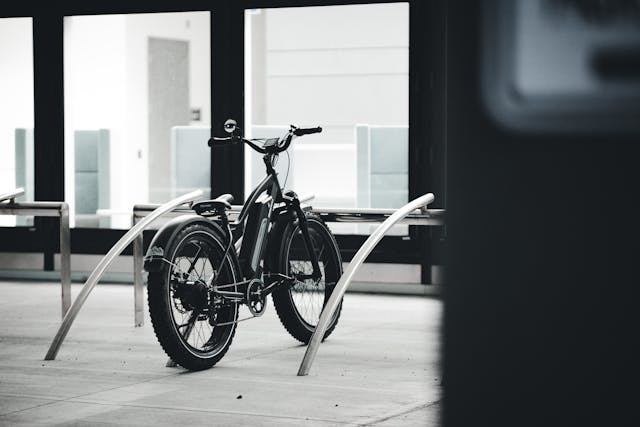
3. Try Removing Battery (Even if Bike Fits on Rack)
If your e-bike almost fits except for the battery area, simply detach the battery before mounting.
This isn’t just about making it fit. It’s also about protecting your expensive battery from damage. The constant vibrations from traveling, especially over bumpy roads, can potentially harm battery components.
Hit an unexpected pothole while driving through unfamiliar territory, and your bike might jostle enough to damage internal battery connections.
Better to transport the battery separately inside your vehicle where it’s protected from both physical damage and extreme temperatures.
Is Putting an E-Bike on a Regular Bike Rack Safe?
Absolutely! (Provided you secure it properly.)
Just like with a conventional bicycle, proper fastening is essential to prevent accidents or losing parts along the journey.
The additional weight of an e-bike means you should be even more thorough in checking that all straps and anti-theft bicycle locks are firmly in place before setting off.
Can You Transport My E-Bike on the Highway on a Regular Bike Rack?
While possible, highway transportation presents unique challenges due to e-bikes being substantially heavier than standard models.
At interstate speeds, the force pushing against your vehicle and rack is dramatically higher than when cruising at 20 mph on backroads.
You simply can’t risk the potential costs, embarrassment, or harm that might result from improperly transporting an e-bike. If your bike comes loose at highway speeds, best case scenario, you’ve lost or damaged an expensive bike.
Worst case?
You could cause a serious accident endangering yourself and others. Double-check everything before hitting the fast lane.
Safest Way To Transport an E-Bike on a Bike Rack?
Trust your instincts.
If something feels off about how your e-bike sits on the rack, don’t ignore that feeling.
When your inner voice is screaming “No! Don’t do it!” it’s usually worth listening to that warning.
From what I’ve seen, the safest approach uses racks specifically designed with wheel trays, where both wheels sit securely in grooves with a top latch holding the bike firmly in place.
These platform-style racks distribute weight evenly and minimize movement during transit.
Will My E-Bike Stay on a Hitch-Mounted Bike Rack?
If you’re using a rack that doesn’t feature wheel slots to secure the wheels before strapping down the frame, proceed with extra caution.
That said, your e-bike should remain secured if the rack is properly rated to handle its weight.
The key is ensuring everything is tightly fastened before heading out.
Can You Place an E-Bike on a Roof Bike Rack?
Technically yes.
(You can check out the Thule UpRide roof bike rack if you need one).
But consider the practicality.
Lifting a heavy e-bike overhead onto your vehicle’s roof isn’t exactly a cakewalk, and getting it back down can be even trickier!
Whenever possible, opt for hitch-mounted racks instead. If a roof rack is your only option, protect your back and shoulders by using a sturdy stepladder for loading and unloading.
Your spine will thank you later.
How to Make Sure Your Electric Bike Won’t Fall
While rack manufacturers design their hardware with safety in mind, not every company produces equally reliable products.
Research brands with solid safety reputations before purchasing.
Still concerned?
Add extra security measures like ratchet straps or bungee cords to reinforce your roof or hitch rack setup.
Just ensure any additional fasteners remain tight enough throughout your journey.
Loose straps that dangle could potentially get caught in your wheels if they’re long enough, creating an entirely different safety hazard.
What E-Bike Rack Do You Recommend?
Any rack that properly supports your e-bike’s construction, dimensions, and weight will serve you well.
Many newer models accommodate both conventional and electric bikes.
When shopping for a rack, I’d prioritize these features:
1. Safety Features
Look for features that prioritize security and visibility, especially when transporting heavier or more expensive bikes like e-bikes.
Ratchet straps are a standout option as they lock your bike into place with a snug, adjustable fit that won’t loosen mid-drive.
They’re also user-friendly and quick to secure, making them ideal for both short trips and long-distance travel.
Beyond the straps, several other features can significantly enhance safety, stability, and visibility on the road:
- Grab arms for added holding power
- Hook or belt closures for tight fit
- Reflectors visible from all angles
- Extra mounting points for bike lights
- Heavy-duty steel hitch pin construction
- Compatibility with specialized rack straps
These features make for a bike rack setup that minimizes risk, protects your gear, and gives you one less thing to worry about during your journey.
2. Security Features
Look for racks with intuitive locking systems.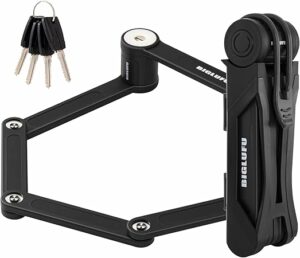
These not only prevent your bike from detaching while driving but also deter theft during stops.
Hinged and spring locks that accommodate padlocks work well, or choose racks with built-in locking mechanisms.
You can also find foldable security features available as standalone accessories.
3. Convenience Features
A tilting function makes loading bikes and accessing your trunk significantly easier.
While I classify this as a convenience feature, it definitely improves safety too, preventing potential back strain, especially for shorter riders like myself.
Quick-release levers are another feature I wish my rack had.
They make mounting and dismounting an already heavy e-bike much less cumbersome, reducing the chance of dropping your bike during loading or unloading.
4. Practicality
Be wary of “one-size-fits-all” bike racks, particularly for long-distance travel.
That said, investing in one high-quality rack compatible with all your e-bikes simplifies life considerably.
If it works with multiple vehicles or features a universal design, switching between cars becomes much more straightforward.
What Are the Most Important E-Bike Rack Features?
Weight capacity tops the list without question.
If you notice your rack frame bending where it shouldn’t, that’s a serious red flag. Always verify your rack’s weight limitations before trusting it with your expensive electric bike.
For ensuring your bike remains firmly attached to your vehicle, you might consider a hitch cargo rack as an alternative, provided it can accommodate bicycles.
I emphasize this because secure attachment to your vehicle must be your primary concern, keeping both you and others safe while traveling.
Types of Bike Racks That Work Well for E-Bikes
1. Platform Hitch-Mounted Racks
These provide the sturdiest option for transporting electric bikes.
Attaching directly to your vehicle’s hitch receiver, they typically feature wheel trays that secure both wheels while supporting the entire bike at its lowest point.
Quality platform racks designed for e-bikes offer weight capacities of 60+ pounds per position.
They usually feature ratcheting arms that secure the front wheel without contacting the frame which is perfect for e-bikes with sensitive electronic components.
Premium models like the Thule EasyFold XT even include loading ramps, making it dramatically easier to get your heavy e-bike positioned properly.
These designs also typically space bikes further apart, preventing them from knocking against each other during transit.
2. Hanging Hitch Racks
These support bikes by their frames instead of wheels.
While more affordable than platform styles, they’re generally less suitable for e-bikes due to lower weight ratings and awkward hanging positions required.
If budget constraints point you toward a hanging rack, ensure it offers at least a 50-pound per-bike capacity and frame clamps designed for potentially thicker or irregularly shaped e-bike tubing.
Remember that many e-bike frames, especially step-through or unusual designs—may not secure properly on hanging-style racks.
3. Roof Racks
Mounting to your vehicle’s roof rails or crossbars, these come in wheel-mount or frame-mount varieties.
While they free up rear access and don’t block your trunk, the major drawback is obvious: lifting a heavy e-bike overhead.
If you possess the strength and height to manage this safely, look for roof systems with robust weight capacities specifically engineered for heavier bicycles.
For example, the Thule UpRide that I mentioned earlier, handles bikes up to 44 pounds which is sufficient for lighter e-bikes if you remove the battery beforehand.
4. Truck Bed Solutions
For pickup owners, specialized mounts can secure e-bikes in your truck bed.
Options range from simple wheel chocks to comprehensive systems securing both wheels without frame contact.
The advantage here is clear: reduced lifting height compared to roof racks, plus truck beds typically handle substantially more weight than hitch or roof systems.
Just ensure bikes remain properly secured against shifting during travel.
What Are the Most Important E-Bike Rack Features?
1 . The Weight Factor
The most obvious hurdle is simply how much heavier electric bikes are compared to traditional bicycles.
While standard road bikes might weigh 20-30 pounds, e-bikes typically range from 40-70 pounds.
This extra heft not only tests rack weight limits but makes loading and unloading considerably more demanding.
Always check your rack’s per-bike position weight capacity, not just its total rating.
Some racks advertise 120-pound capacities but only support 40 pounds per bike, fine for three conventional bikes but potentially inadequate for even two e-bikes.
2. Unusual Frame Geometry
Electric bikes often feature non-standard frame designs accommodating batteries, motors and wiring.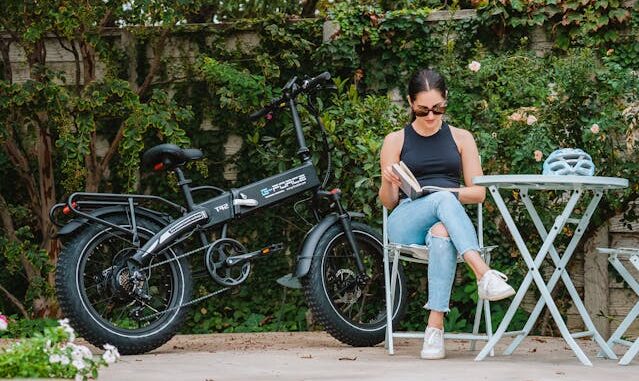
Step-through frames, mid-drive motor housings, and rear-hub motors can all interfere with traditional rack mounting systems.
Platform-style racks securing bikes by their wheels rather than frames typically work better with unusual e-bike geometries.
If your rack uses frame contact points, verify compatibility with your specific e-bike model before traveling.
3. Tire Compatibility
Many e-bikes feature wider tires than conventional bicycles.
Fat-tire electric models can sport tires up to 4 inches wide which is too substantial for standard wheel trays on many racks.
When selecting an e-bike rack, prioritize models with adjustable or extra-wide wheel trays. Some manufacturers offer fat tire adapters as accessories, allowing standard racks to accommodate wider rubber.
Bike Racks for Different Types of E-Bikes
1. Folding E-Bikes
The unique advantage of folding electric bikes is their compact potential, many fold small enough to fit in your trunk, eliminating external rack needs entirely.
If your e-bike folds, consider whether this simpler solution works before investing in specialized racks.
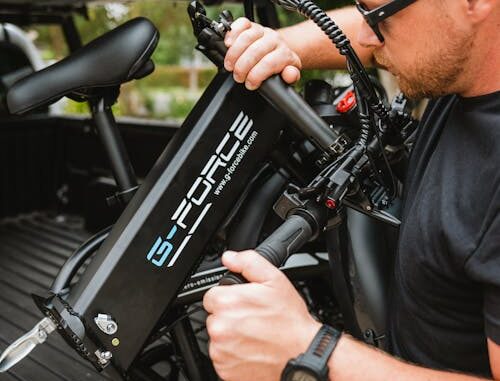
For larger folding models still requiring racks, the reduced folded dimensions might allow using racks with lower weight capacities, provided the measurements remain compatible.
2. Fat Tire E-Bikes
These present unique challenges due to their exceptionally wide tires (typically 3-4 inches) and frequently heavier construction.
Standard racks rarely accommodate these wider tires in their wheel trays.
Look specifically for racks advertising fat bike compatibility or offering adapter kits.
Models like the Thule T2 Pro XT and certain Rocky Mounts options provide specific fat tire solutions. Remember that these bikes’ additional weight means requiring racks with higher capacity ratings.
3. Cargo E-Bikes
Among the most challenging to transport, cargo e-bikes often weigh 80+ pounds and measure significantly longer than standard bikes.
Few conventional racks handle these specialized machines.
For these behemoths, consider trailer-based transport solutions or truck bed options rather than traditional bike racks.
Some cargo bike owners use lightweight trailer hitches allowing them to tow their cargo bike directly behind their vehicle.
4. Step-Through Frame E-Bikes
Popular for their accessibility, step-through designs (sometimes called low-step or open frames) can be incompatible with racks using the top tube for mounting.
Platform-style racks securing bikes by wheels work best with these frames.
If using a hanging-style rack becomes necessary, special adapter bars creating temporary “top tubes” for hanging purposes might solve your problem.
Prepping Your E-Bike for Transport
1. Secure or Remove Loose Parts
Before loading, remove or firmly secure any accessories that might detach during transit.
Water bottles, phone mounts, panniers, and detachable lights should all be removed.
Check that any items attached to rear racks are either removed or thoroughly secured.
2. Clean First, Travel Later
This might seem unnecessary, but cleaning your e-bike before transport serves dual purposes.
First, it prevents dirt transfer to your vehicle and clothing during loading.
Second, it provides an opportunity to inspect for loose components or potential issues before hitting the road.
3. Check Tire Pressure
Ensure properly inflated tires before mounting your e-bike.
Under-inflated tires shift more in wheel trays during travel, potentially damaging wheels or compromising rack security.
A quick pressure check takes seconds but prevents numerous potential problems.
4. Protect Your Electronics
If your e-bike features a digital display or control panel, consider covering it with a soft cloth or protective cover during transport.
This shields sensitive electronics from road debris, precipitation, and UV damage throughout your journey.
Ways to Ensure a Safe E-Bike Transport
1. Vehicle Weight Limits
Remember that a heavy bike rack plus one or more e-bikes substantially increases weight on your vehicle’s hitch or roof.
Check your vehicle manual for tongue weight limits (for hitch racks) or roof weight capacities (for roof racks) and ensure your fully loaded setup remains within these parameters.
2. Driving Adjustments
Transporting e-bikes externally requires modifying your driving approach.
Take corners more gradually, allow increased stopping distances, and remain aware of additional height when using roof racks.
Most experts suggest maintaining speeds below 70 mph when carrying bikes externally.
3. Insurance Protection
Before traveling with expensive electric bikes, verify coverage with your auto and homeowner’s insurance providers.
Some policies cover bikes during transport while others don’t.
For high-value e-bikes, consider supplemental coverage or specialized bicycle insurance including transport protection.
4. Test Before Traveling
Planning an extended journey with your e-bike?
Conduct a test run first. Load your bike and take a short drive, then inspect all mounting points and straps.
Listen for unusual noises and observe how the bike sits on your rack. Make necessary adjustments before embarking on longer trips.
When properly secured on an appropriate rack, your electric bike can safely accompany you wherever adventure beckons.
5. Flying With an E-bike?
If you want to take your e-bike overseas, then there are specific nuances you should know about. Check out my separate post on flying with an electric bike for further details.
All in all…
With suitable equipment and preparation, you’ll enjoy the freedom of e-biking in exciting new locations beyond your neighborhood.
Now I’d like to hear from YOU:
- Can you put an electric bike on a bike rack smoothly, in your opinion?
- Got any tips, tools, or lessons learned the hard way?
Share in the comments below. I’d love to hear what worked (or didn’t) for you!

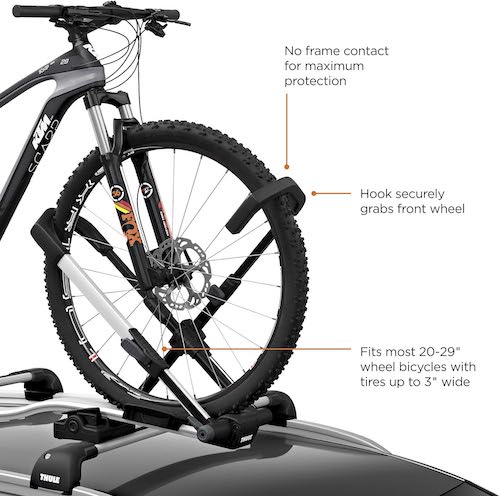
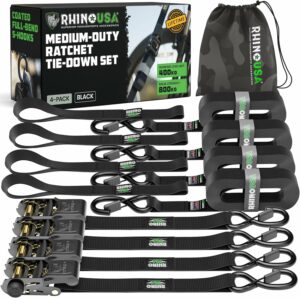
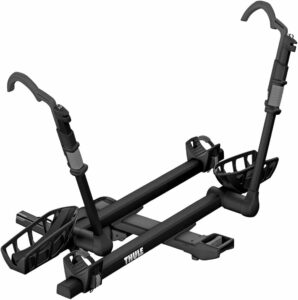

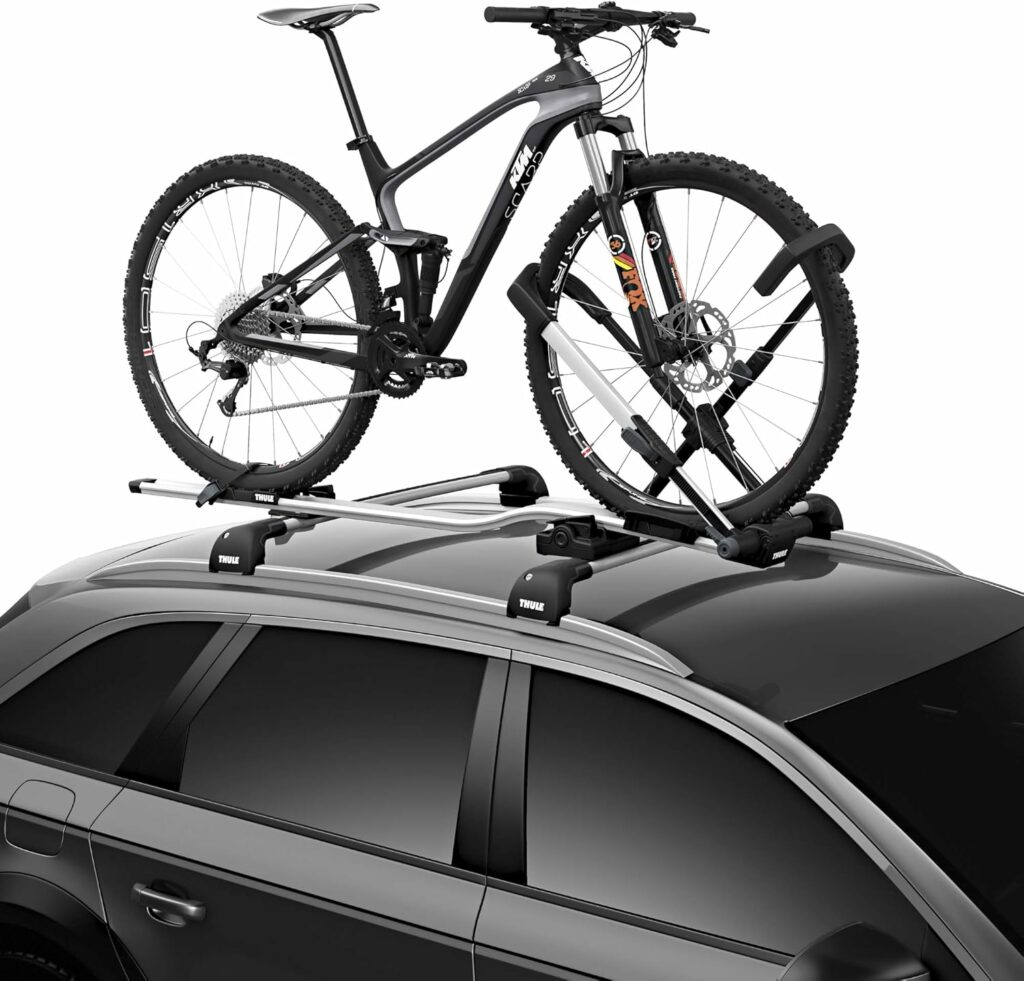
Be the first to comment